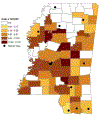Relationship Between Environmental Air Quality and Congenital Heart Defects
- PMID: 35759718
- PMCID: PMC9245123
- DOI: 10.1097/NNR.0000000000000590
Relationship Between Environmental Air Quality and Congenital Heart Defects
Abstract
Background: Congenital heart defects (CHDs) affect 40,000 U.S. infants annually. One fourth of these infants have a critical CHD, requiring intervention within the first year of life for survival. Over 80% of CHDs have an unknown etiology. Fine particulate matter ≤2.5 (PM2.5) and ozone (O3) may be air pollutants associated with CHD.
Objectives: The purpose of this study was to explore relationships between first-trimester maternal exposure to air pollutants PM2.5 and O3 and a critical CHD diagnosis.
Methods: A retrospective cohort study with nested case controls was conducted using data from January 1, 2014, to December 31, 2016, and consisted of 199 infants with a diagnosed critical CHD and 550 controls. Air pollution data were obtained from the U.S. Environmental Protection Agency air monitors. Geographic information system software was used to geocode monitoring stations and infant residential locations. Data analysis included frequencies, chi-square, independent t-test analysis, and binary logistic regression for two time periods: the entire first trimester (Weeks 1-12) and the critical exposure window (Weeks 3-8 gestation).
Results: Critical CHD odds were not significantly increased by exposure during the first trimester. However, weekly analyses revealed CHD odds were higher in Weeks 5 and 8 as PM2.5 increased and decreased in Week 11 with increased O3 exposure.
Discussion: Our study shows no evidence to support the overall association between air pollutants PM2.5 and O3 and a critical CHD diagnosis. However, analyses by week suggested vulnerability in certain weeks of gestation and warrant additional surveillance and study.
Copyright © 2022 Wolters Kluwer Health, Inc. All rights reserved.
Conflict of interest statement
The authors have no conflicts of interest to report.
Figures
References
-
- Botto LD, & Correa A (2003). Decreasing the burden of congenital heart anomalies: An epidemiologic evaluation of risk factors and survival. Progress in Pediatric Cardiology, 18, 111–121. 10.1016/S1058-9813(03)00084-5 - DOI
Publication types
MeSH terms
Substances
Grants and funding
LinkOut - more resources
Full Text Sources
Medical


